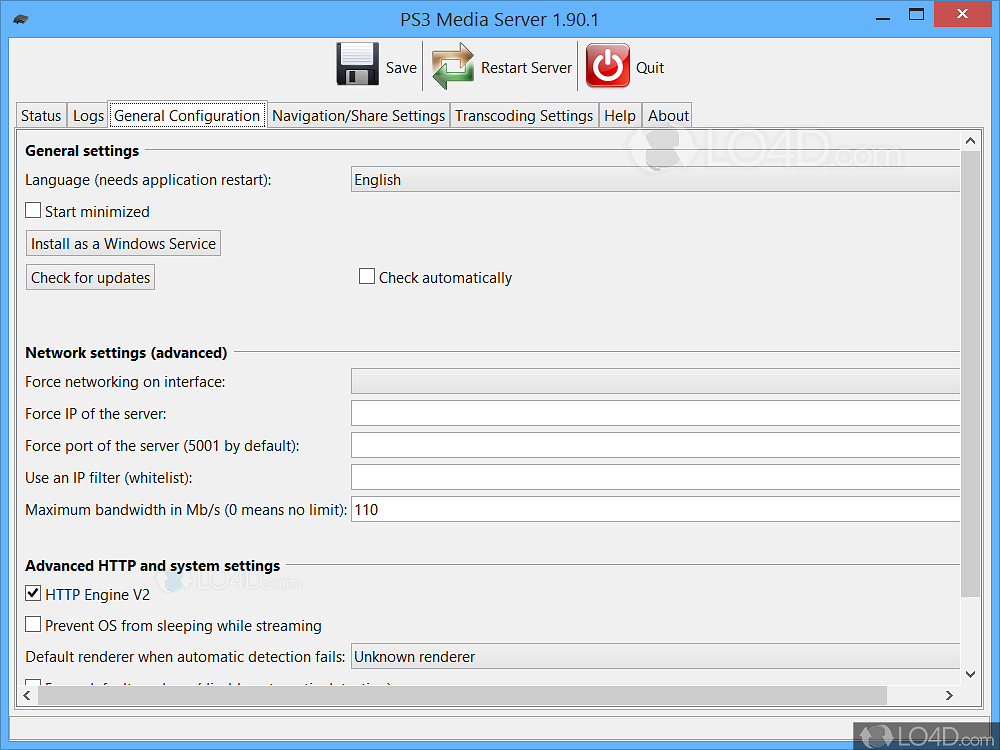
- #PS3 MEDIA SERVER UBUNTU 14.04 INSTALL#
- #PS3 MEDIA SERVER UBUNTU 14.04 UPDATE#
- #PS3 MEDIA SERVER UBUNTU 14.04 PASSWORD#
- #PS3 MEDIA SERVER UBUNTU 14.04 ISO#
- #PS3 MEDIA SERVER UBUNTU 14.04 FREE#
This port is called a display port, and is referred to by VNC as :1. When VNC is first set up, it launches a default server instance on port 5901. Our VNC server has an xstartup file preloaded already, but we need to use some different commands for our XFCE desktop. These commands are located in a configuration file called xstartup. Step Two - Configure VNC Serverįirst, we need to tell our VNC server what commands to perform when it starts up. With these packages installed, you are ready to configure your VNC server and graphical desktop. Vncserver completes the installation of VNC by creating default configuration files and connection information for our server to use. This is a helpful option if you want to demonstrate something to other people using your VNC server.)
#PS3 MEDIA SERVER UBUNTU 14.04 PASSWORD#
Users who log in with the view-only password will not be able to control the VNC instance with their mouse or keyboard. (After you set up your access password, you will be asked if you would like to enter a view-only password. To complete the VNC server’s initial configuration, use the vncserver command to set up a secure password: vncserver
#PS3 MEDIA SERVER UBUNTU 14.04 INSTALL#
Sudo apt-get install xfce4 xfce4-goodies tightvncserver
#PS3 MEDIA SERVER UBUNTU 14.04 UPDATE#
We can get the XFCE packages, along with the package for TightVNC, directly from Ubuntu’s software repositories using apt: sudo apt-get update In this example, we will install XFCE4, which is very lightweight while still being familiar to most users. If this is the case, we’ll need to begin by installing one that we can work with. Step One - Install Desktop Environment and VNC Serverīy default, most Linux server installations will not come with a graphical desktop environment. Once you have your non-root user, you can use it to SSH into your Ubuntu server and continue with the installation of your VNC server. If you haven’t done this yet, you can run through steps 1-4 in the Ubuntu 14.04 initial server setup guide to create this account.

You will need an Ubuntu 14.04 server installed and configured with a non-root user that has sudo privileges. Prerequisitesīefore you begin with this guide, there are a few steps that need to be completed first. This choice will ensure that our VNC connection will be smooth and stable even on slower Internet connections. The VNC server we will be using is TightVNC, a fast and lightweight remote control package. In this guide, we will be setting up VNC on an Ubuntu 14.04 server and connecting to it securely through an SSH tunnel. VNC makes managing files, software, and settings on a remote server easier for users who are not yet comfortable with working with the command line. Thanks to MAAS, administrators can deploy multiple servers at the same time without to much hassle.VNC, or “Virtual Network Computing”, is a connection system that allows you to use your keyboard and mouse to interact with a graphical desktop environment on a remote server.

Summing up, Ubuntu Server is a great server-oriented operating system that can be used in real life scenarios where the need for extremely reliable and stable server machines is a must. Lastly, users will be able to configure how do they want to manage upgrades on the respective system (automatic, manual, or via Landscape), and choose which server software packages to install (OpenSSH, DNS, LAMP, Mail, PostgreSQL database, Print, Samba, Tomcat, Virtual Machine host). In addition, you can configure the network by entering a hostname, set up users and passwords, encrypt the home directory, configure the clock, and partition the disks using normal or encrypted LVM (Logical Volume Manager). When installing the Ubuntu Server operating system, you will be asked to choose the language that will be used during the entire installation process, select your location, and configure the keyboard. It is also important to mention that users will be able to rescue a broken system, run a memory test, or start an existing operating system installed on the first disk drive directly from the boot prompt. The boot prompt of this OS is very important, as it allows users to install the operating system on a single machine, or deploy multiple server installations using Canonical’s MAAS (Metal as a Service) technology. The system is officially supported on the 64-bit (amd64), 32-bit (i386), PowerPC (PPC), PowerPC64 Little-Endian (PPC64el) and 64-bit Mac (amd64) hardware platforms. It is understandable that there’s no live session, because a true server distribution comes without a graphical desktop environment.
#PS3 MEDIA SERVER UBUNTU 14.04 ISO#
It is available for download as installable-only, CD-size hybrid ISO images that can be written to blank CD discs or USB flash drives.

Distributed as installable-only ISO images for numerous hardware platforms
#PS3 MEDIA SERVER UBUNTU 14.04 FREE#
Ubuntu Server is an open source distribution of Linux that provides users with a sophisticated server operating system based on the world’s most popular free OS, Ubuntu Linux.


 0 kommentar(er)
0 kommentar(er)
